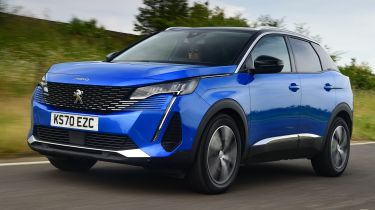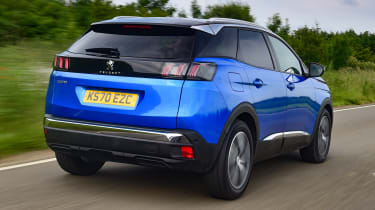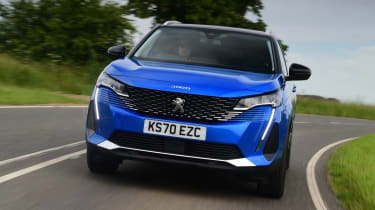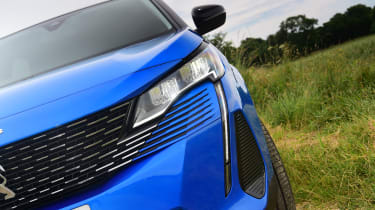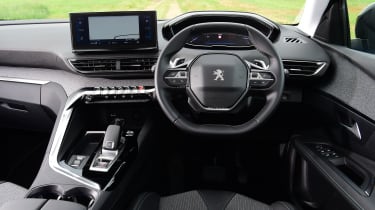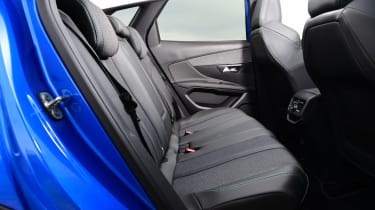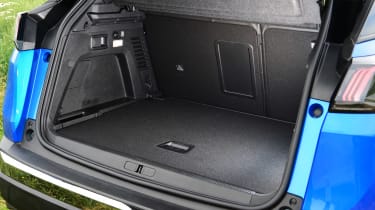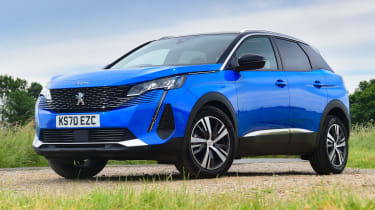Peugeot 3008 (2017-2024) review
The Peugeot 3008 is a front-running crossover that offers a spacious, upmarket cabin and plenty of kit

Just so you know, this is an older review of the 2017-2024 3008. If you are interested in information about the latest Peugeot 3008, or news of upcoming Peugeot models, please follow the links provided.
The outgoing Peugeot 3008 is still a genuine contender in the family SUV class, thanks to its top-notch interior, refinement, and a strong engine range. It’s also practical and decent to drive, if not as enjoyable as some other rivals. It’s comfortable, with a well-judged ride that’s firm enough to stop it from feeling bouncy, yet yielding enough to glide over the worst bumps in the road.
For many, the Peugeot 3008 will offer everything they need: it’s economical, easy to use and feels upmarket, all at a reasonable price. If you’re considering a new family car, the 3008 is one to consider.
About the Peugeot 3008
The second-generation Peugeot 3008 made its debut in 2016, and its angular and sporty exterior design was a massive departure from the boxy, MPV-esque model that it replaced. The interior took a big step upmarket, too, with a generous helping of plush materials accompanying Peugeot’s i-Cockpit technology. A facelift in 2021 introduced some sharper styling cues from the 208 supermini, including the brand’s distinctive ‘fang’ running lights.
Used - available now
The Mk2 3008’s days are now numbered, though, as the new E-3008 has arrived as the first model in the Mk3 3008 lineup. The incoming 3008 range sits on a brand-new platform with only plug-in hybrid and fully-electric power set to be available. Order books for the electric E-3008 are already open, and the Mk3 will fully replace the older 3008 when the PHEV arrives in mid-2024.
The Mk2 Peugeot 3008 definitely took a big step up in terms of luxury appeal, but Peugeot also ensured that the 3008’s crucial family car credentials remained. The 591-litre boot is bigger than you’ll find on a Nissan Qashqai, and there’s plenty of room for all but the very tallest passengers.
There’s a wide range of choice when it comes to power, too, with petrol, diesel, hybrid and plug-in hybrid power all on offer. This level of powertrain variety means the 3008 is able to appeal to a variety of buyers, but it also brings it into the firing line of several capable competitors. Some of the Peugeot's closest rivals are big-sellers, too, such as the Nissan Qashqai, Ford Kuga, Skoda Karoq, Hyundai Tucson and Kia Sportage.
As with a number of Stellantis models, the Peugeot 3008 has some closely-related siblings. If you fancy something a little bit less flamboyant, the Vauxhall Grandland shares the same underpinnings. If, on the other hand, you want something with more flair, both the Citroen C5 Aircross and DS 7 also share the same architecture while offering different styling and driving characteristics.
As a rule, all of these models provide plenty of room for five adults and luggage, but if you want more space than the 3008 can provide, you can opt for the larger 5008 seven-seater, which shares the same platform in stretched form, along with most of its engines.
The 3008’s engine range features a line-up of modern mild-hybrid and plug-in hybrid (PHEV) options, along with a more traditional turbocharged petrol and a BlueHDi diesel for those who regularly rack up big mileages. All 3008s have an automatic gearbox. The 1.2 petrol and 1.2 mild-hybrid use a six-speed auto, while the diesel and plug-in hybrids use an eight-speed automatic.
If you’re a keen off-roader, you may be disappointed to hear that the 3008 isn’t available with four-wheel drive. However, Peugeot has developed its Grip Control system to provide something of an alternative. Short of the most extreme off-roading, this system should provide all the traction you’ll probably need. Where fitted, it adds a rotary controller to the centre console, allowing you to select the driving mode suitable for snow, gravel, mud or tarmac.
Unlike other Peugeot model ranges, there's no entry-level Access model, so the line-up starts with the well-equipped Active model. Beyond that, Allure and GT trims are offered. All models come with 12.3-inch digital dials, an 8.0-inch infotainment touchscreen, Apple CarPlay, Android Auto, two-zone climate control, LED headlights, and a 180-degree colour reversing camera.
The sweet spot in the range is arguably the Allure, which features a bigger 10-inch touchscreen, integrated sat-nav, keyless go and upgraded upholstery. The top-spec GT offers niceties like front parking sensors, Alcantara seat trim and extra driver assistance systems. Pricing starts from just under £33,000.
Used and nearly new
The second-generation Peugeot 3008 has now been around long enough that clean, low-mileage examples of earlier models are starting to creep under the £11,000 mark. Both the 1.2-litre petrol and 1.6-litre diesel can be found in abundance on the used market, and you’ll even have a decent range of colours to choose from.
For the biggest savings, the Mk1 is available from around £3,000. However, these cars are now starting to look and feel rather dated.
Peugeot 3008 history
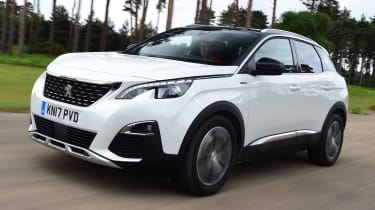
Peugeot 3008 Mk2: 2017-2024
The 3008 model range received a facelift in 2020, with minor styling revisions to an already good-looking family SUV. We named it our mid-size SUV of the year when it was first launched in 2017, highlighting the 3008's design and onboard tech as key improvements over its rather dowdy predecessor.
There are two efficient plug-in hybrid models to choose from: the front-wheel-drive Hybrid 225 e-EAT8 and the four-wheel-drive Hybrid 300 e-EAT8, although these models cost more than the standard petrol and diesel cars. Read our full Mk2 Peugeot 3008 buyer’s guide here…
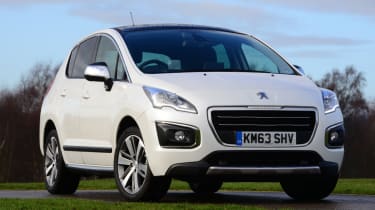
Peugeot 3008 Mk1: 2008-2016
Peugeot launched the 3008 with a focus on practicality, low running costs and decent levels of comfort. It's fair to say it succeeded in these areas, although the 3008's rather bland design could have been more appealing.
Pick a diesel model, and you'll appreciate the excellent fuel economy. We'd recommend the manual gearbox, particularly over the awkward Electronic Gearbox Controlled Manual (EGC) semi-automatic. Read our full Mk1 Peugeot 3008 buyer’s guide here…
Engines, performance and drive
Although the Peugeot 3008 is focused on comfort and uses an uncomplicated suspension set-up, Peugeot’s engineers have worked hard to improve the 3008’s dynamic ability. For the most part, they’ve risen to the challenge and produced something that meets the brief most would expect of a family-orientated SUV.
You immediately feel that the 3008 is softer and more forgiving than firmer rivals like the SEAT Ateca. The long-travel suspension in the Peugeot soaks up bumps well, while some deft suspension tuning means it remains composed on all but the worst roads. Head out onto the motorway, and the 3008 offers strong refinement and comfort, allowing you to tackle long trips without feeling tired.
Push the Peugeot through a series of corners on a B road, and its softer focus is evident. There’s more roll than you’ll find in an Ateca, and big steering wheel movements can upset the car. Keep the pace slower where the 3008’s is more in its comfort zone, and its strong reserves of grip shine through. Its steering is well-weighted and accurate while being light enough at low speeds to ease town driving. A decent 10.7-metre turning circle almost makes a mockery of the Renault Austral with its elaborate four-wheel steering system.
The eight-speed gearbox fitted to the 1.2 PureTech and 1.5 BlueHDi is smooth once on the move, but driving in slow-moving traffic is incredibly frustrating. The stop-start system is the issue here; it engages too soon when coming to a halt and jams the brakes on in the process. Ease off the pedal to make the car perform a more gentle halt, and the engine tends to fire up. It takes the shine off what would otherwise be a slick powertrain.
The e-DSC6 used in the 134bhp 1.2 hybrid is a dual-clutch automatic similar to what’s been used on Volkswagen cars for years. Peugeot’s take on it has an electric motor in the gearbox to allow it to drive for short distances at low speed under electric power alone, and provide a small power boost when accelerating. It’s much smoother than the eight-speed auto around town and should bring fuel economy benefits if you can utilise its EV mode as much as possible. Its help at higher speeds is negligible, though.
0-62mph acceleration and top speed
There's one petrol engine, one diesel, one mild-hybrid petrol, and two plug-in hybrids in the Peugeot 3008 line-up, all offering various power outputs.
The line-up starts with the 1.2-litre three-cylinder PureTech 130 petrol, which is a little more potent than the 1.0-litre TSI found in the SEAT Ateca. The 1.2 PureTech produces 129bhp and 230Nm of torque, and comes paired with an eight-speed automatic gearbox. It’s a great choice, being quiet at low revs and sounding sweet as you get up to speed. The 0-62mph of 9.7 seconds is highly respectable in this class.
The 1.5 BlueHDi 130 has 128bhp and 300Nm torque. It’s more of a relaxed lugger than a performer; its claimed 0-62mph is a leisurely 11.5 seconds.
You’d be wise to check out the 134bhp 1.2 hybrid instead because it’s nearly as quick as the petrol — 0-62mph takes 10 seconds — but it has economy figures that are similar to the diesel, all with greater refinement.
For even greater refinement, you’ll need either of the two plug-in hybrid models, which can travel around 40 miles on purely-electric power. The entry-level Hybrid 180 makes 178bhp and 360Nm of torque when its turbocharged 1.6-litre petrol engine and electric motor work together. It’s quicker than the more powerful 222bhp Hybrid 225 version, hitting 62mph in 8.0 seconds rather than 8.9 seconds, respectively. The upside of picking the latter is it will do up to 41 miles on a charge and, therefore, sits in a lower company car tax band than the Hybrid 180, which will only cover 36 miles.
MPG, CO2 and running costs
The Peugeot 3008 offers quite a wide range of petrol, diesel, hybrid and plug-in hybrid powertrains.
The base three-cylinder petrol engine is 1.2-litre PureTech unit which is capable of returning up to 46.4mpg, with CO2 emissions starting at 138g/km. When we pitted this version of 3008 against a Nissan Qashqai and Hyundai Tucson in a group test, the Peugeot was the most efficient of the three as it returned 46mpg, compared to the Qashqai's 44.1mpg and Tucson's 43.5mpg.
The 128bhp 1.5 BlueHDi diesel offers slightly better fuel economy of up to 54.1mpg and as little as 137g/km emissions of CO2. Driving modes include Eco, Normal and Sport, which you can toggle through for a little extra response, or to eke out a few extra miles from the tank.
As we mentioned earlier, the 1.2 hybrid is almost as efficient as the diesel, with an economy figure of 50.4mpg, plus its emissions are the best of the non-plug-in range at 126g/km.
Electric range, battery and charging
If you regularly charge the batteries, Peugeot claims it is possible to see as much as 250mpg from the plug-in hybrid (PHEV) versions of the 3008, and cover up to 41 miles on electric power alone.
The least expensive is the Hybrid 180, which uses a 12.4kWh battery pack, while the Hybrid 225 uses a 14.2kWh battery. The extra battery capacity of the Hybrid 225 over the Hybrid 180 enables slightly better fuel economy and a few more miles of electric-only running. However, the difference is small enough to be negligible in real-world driving.
All 3008 PHEVs can be fully recharged in around one hour and 45 minutes if you use a standard 7.4kW home wallbox charger.
Insurance
Petrol and diesel models reside in insurance group 22, meaning premiums won't be cheap, but they aren’t excessive for this class either. Expect to pay more to insure a hybrid model, though, as these start from group 29.
Depreciation
Expert data suggests that the Peugeot 3008 will retain between 33 and 46 per cent of its value over a typical three-year/36,000-mile ownership period. This means every version of the Peugeot fares worse than its Renault Austral rival, which should return closer to 55 per cent of its initial value over the same period.
To get an accurate valuation on a specific model check out our free car valuation tool...
Interior, design and technology
The Peugeot 3008 is a handsome-looking machine. The upright grille and chunky bodywork give it a unique look, and it’s certainly a big step forward from the previous model. Whereas the Mk1 was an MPV-style crossover, this latest model is a genuine SUV. The detailed headlight and tail-light designs are stand-out features, and the steep windscreen, raised ride height and hidden C-pillars all add to the look.
Inside, the 3008 has a superb interior. It wraps around the driver from the centre console to the door, and it incorporates Peugeot’s latest infotainment system with an eight-inch touchscreen in Active petrol and diesel models, and a 10-inch screen in all other models. The small steering wheel and high-set instrument cluster we’ve already seen in the rest of the company’s range also appear.
The 3008 comes with Peugeot’s i-Cockpit display, which incorporates a 12.3-inch screen behind the wheel. It’s similar to Audi's Virtual Cockpit, and means you can change the layout from traditional dials to displaying various trip or driving assistance screens, or – as we’ve found particularly useful – show sat-nav directions on a map. Switching between screens isn’t as easy as in an Audi, and some people may find the layout takes a bit of getting used to.
The materials you touch are of excellent quality, with metal accents giving the cabin an upmarket feel. Due to the dashboard's wrap-around design, it doesn’t seem as spacious as a Nissan Qashqai or SEAT Ateca, but that’s an illusion since two grown adults can sit comfortably in the front of a 3008. The only minor setbacks are the air-con controls incorporated into the touchscreen display, making them hard to use on the move. And if we’re being picky, the materials lower down in the cabin are of the hard, scratchy kind.
Sat-nav, stereo and infotainment
Entry-level 3008s get a 12.3-inch digital dash display, and an eight-inch central touchscreen. The Active plug-in hybrid, plus all other models in the range, get a larger 10-inch touchscreen display, which on Allure and above includes built-in 3D navigation. Every 3008 is fitted with Apple CarPlay and Android Auto as standard.
Although the graphics for both the digital instrument panel and the central 10-inch touchscreen are visually appealing, the operating system is flawed, and lags behind the slicker set-ups from rivals such as the Hyundai Tucson and Kia Sportage.
The 3008's set-up also lacks processing power, with slow loading times a particular bugbear. During our long-term test, we found that entering a postcode and loading a route took a tardy 32 seconds, while the screen took a while to respond to touches.
The big screen isn’t used to its full potential, either. Black bars on either side of the screen provide climate-control shortcuts, but take space from navigation and smartphone mirroring pages. In other words, the screen always looks much smaller than it is.
Practicality, comfort and boot space
Under the 3008’s sharp exterior is Peugeot’s EMP2 platform. The platform is shared among the Stellantis brand to produce a whole family of family SUVs, including the Citroen C5 Aircross, DS 7, and Vauxhall Grandland.
Peugeot has clearly focused on balancing practicality with an upmarket feel, because the design, layout and material quality all feel a step ahead of rivals. It offers a degree of panache few can pull off at this price range.
The Peugeot 3008 is a five-seater with a five-door layout that's normal for any car in this class. if you want seven seats, you'll need to choose the 5008 instead.
Forward visibility is reasonable because the driving position is relatively high. Like most cars in this class, the rearwards view isn’t the best due to the small rear window. All models come with rear parking sensors and a reversing camera to help, but only the range-topping GT has front parking sensors. No 3008 has a 360-degree camera system.
A narrow-diameter steering wheel and digital instrument cluster sitting above it, rather than viewed through it, won’t suit all drivers, but with this second iteration of the i-Cockpit layout, Peugeot has refined the concept. It works much better with the raised driving position of an SUV than it does in a smaller supermini, such as the Peugeot 208.
The cabin layout is more sculptural than some rivals, so there isn’t quite as much versatile storage, but the Peugeot still features plenty of cubbies to store phones and wallets, along with a large central cubby that doubles as an armrest.
Size
The Peugeot 3008 is just over 4.4m long and 1.8m wide (or nearly 2.1m with the mirrors included), which makes it a little longer than the Nissan Qashqai, SEAT Ateca, and Skoda Karoq, but shorter than the Hyundai Tucson and Kia Sportage.
Leg room, head room & passenger space
Hop in the back, and you’ll find that the 3008 has plenty of space. It’s slightly longer than a Qashqai, so there’s plenty of legroom in the back seats, and headroom shouldn’t be an issue for anyone but the tallest passengers.
Occupants in the back benefit from a flat floor, which means the Peugeot is a comfortable choice if you regularly carry three passengers in the rear, because no one will be fighting for foot space.
Boot Space
The Peugeot 3008 provides a cavernous 591-litre capacity boot. Open the large tailgate of petrol, diesel, and mild-hybrid models, and a luggage area with a low load lip and wide opening greets you. It’s well-shaped and has a small amount of storage under the floor, which can be lowered for more space or raised to create a flat base when the rear bench is folded.
The 3008’s boot space dwarfs the 430-litre load area in the Qashqai and beats the 510-litre space in the Ateca. The Skoda Karoq only comes close with a 588-litre capacity when the back seats are slid all the way forward. The advantage isn’t as great if you fold the rear seats down, but the Peugeot’s maximum 1,670-litre load bay is still ahead of its rivals.
The boot also features a fully removable floor, a full-sized spare wheel, and a handy storage net to keep items steady in the back.
Do keep in mind that the plug-in hybrid models have a much smaller boot because the floor needs to be raised due to the battery pack living beneath the luggage compartment. This is the same for most PHEVs.
Towing
No 3008 is particularly suited to towing, with the 1.2-litre Puretech 130 petrol unusually being the best of the bunch, with a maximum braked trailer weight of 1,400kg. That goes down to 1,300kg for the 1.5-litre diesel, and only 1,250kg for each of the hybrids.
If you want a car of this size that’ll easily tow any trailer or caravan, look at the Volkswagen Tiguan. In either 2.0 TDI diesel or 2.0 TSI petrol four-wheel drive form, it’ll pull up to 2200kg.
Reliability and safety
The second-generation 3008 finished in 37th place on the list of best cars to own based on our latest Driver Power owner satisfaction survey. That puts it ahead of rivals such as the Skoda Karoq, previous generation Nissan Qashqai, Citroen C5 Aircross, Volkswagen Tiguan, and SEAT Ateca, but behind the likes of the Toyota RAV4 and old Kia Sportage. As a brand, Peugeot came in ninth spot in the best car manufacturer rankings — out of 32 brands — behind Korean rival Kia, but ahead of Nissan, Skoda, SEAT, Vauxhall, VW, and Renault.
The 3008 features a host of safety equipment and driver aids, including automatic emergency braking, lane departure warning and lane-keeping assist. Step up to Allure for automatic high beam assistance, while adaptive cruise control and blind spot detection are reserved for range-topping GT.
Unfortunately, the 3008 was crash tested by Euro NCAP long ago in 2016, and the test criteria has changed so much in the interim that this rating has expired. That’s not to say the 3008 wouldn’t protect you well in a collision, but a host of newer rivals tested under the latest criteria, such as the Kia Sportage and Renault Austral, are likely to protect you even better.
Warranty
The Peugeot 3008 has a two-year unlimited mileage warranty from the factory and an extra year from the dealer, adding up to three years. That matches the industry standard, although it can't match Kia's seven-year cover and Toyota's ten-year package.
Servicing
The 1.2 hybrid needs servicing every 12 months or 12,500 miles, while the 1.2 PureTech requires servicing annually or every 16,000 miles, and the diesel and plug-in hybrids need checking every 12 months or 20,000 miles.
Peugeot offers fixed-price servicing packages to help spread the cost of scheduled maintenance, and costs around £20 per month.
